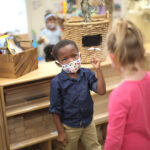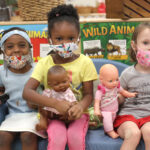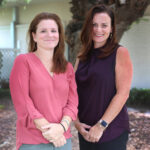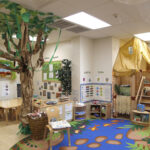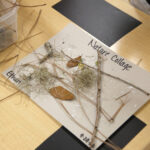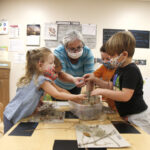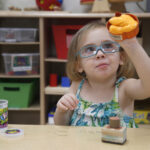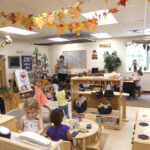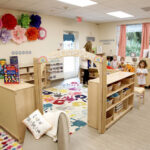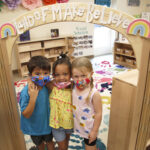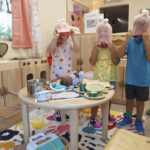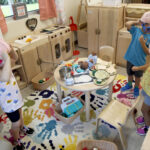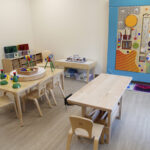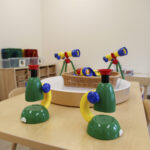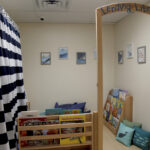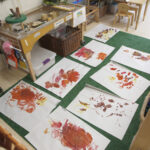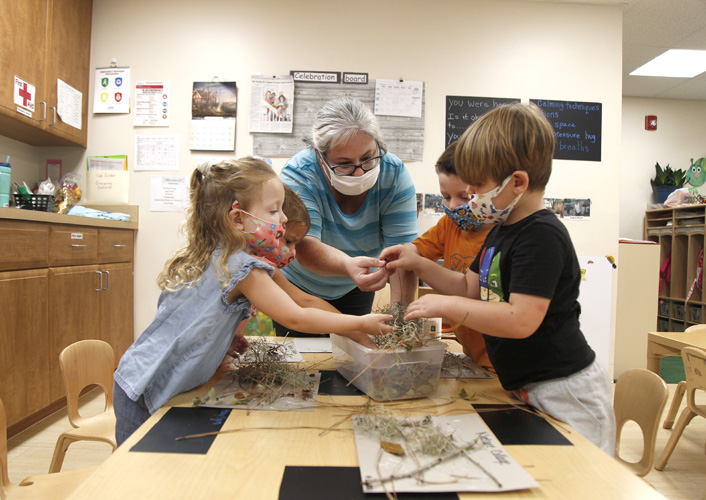
School is fully back in session for our littlest residents – preschoolers from infancy to age 5 – at the Childcare Resources School, which had pivoted to virtual classrooms after the coronavirus pandemic shut everything down on March 16.
Shannon McGuire Bowman, Childcare Resources executive director, explained that after almost three months of virtual learning, the school reopened June 8, albeit with half the number of children, when the state went into Phase 2 and approached full capacity by Aug. 24.
Because their parents are required to work full-time, go to school full-time or a combination of the two, only a handful of parents opted not to send their little ones back.
There was no lack of interested parents to fill those spots; even pre-COVID there was a wait list of 264 children.
“The children have been absolutely joyous to be here; they’re just so happy. We’re delighted to have them, too,” said Bowman. “We thought there might be a little bit rougher transition back to full-time, but it’s been seamless. Everyone was roaring to come back and excited.”
Quite a few new protocols were put into place, some that will likely remain permanent.
“We were already intensely clean because of NAEYC (National Association for the Education of Young Children) standards, but even that’s been kicked up a notch,” said Tara Beard, director of the Childcare Resources School.
All teachers and administrative staff are required to be masked, and they are the only ones that are admitted inside the school.
Every morning, temperatures are taken of parents (also masked) and children, and a series of questions are asked. Drop-off and pickup times are staggered, and midday temperatures are taken of children and staff to catch any fever spikes.
“The parents have been great; they’ve been very respectful and amazing, honestly,” said Beard.
There is no longer any commingling of classrooms or teachers, said Beard, noting “when the children get here in the morning, they go straight into their classroom and remain with their teachers.”
The playground is now assigned by classroom and cleaned after every use, and even teachers can no longer share the breakroom or computer space. Food deliveries of the children’s daily breakfast, lunch and afternoon snacks have been altered, with a staff person meeting the caterers outside the building and delivering the meals to teachers at their classroom doors.
“It’s a little different – a LOT different,” said Beard. “We’re just being really cautious, making sure that should there be an active case with a child, there’s no cross contamination in the classrooms.”
When one teacher did test positive, they temporarily excluded any children and teachers who might have had contact, and all returned after quarantine.
“But that was back in July and it feels like it was two years ago,” said Bowman. “Our whole goal is mitigation. It is just to slow the spread as best we can, because we know that it is so contagious. There’s a lot of intentional separating, and that takes a lot of planning, but it’s becoming old hat now.”
Currently, the children are not wearing masks, but they plan to try it with children ages 3 and up.
“We’re going to see how that works. It’s a transition for sure, to let children be joyful and curious, but we still try and do our best to mitigate,” said Beard.
“We use Conscious Discipline (a social-emotional learning program), so we’re lucky in the sense that there are a lot of greetings that are woven into that program, like fist-bumps and butterfly hellos,” said Beard, adding that “gorilla hugs” and things of that nature are now excluded.
Teachers limit the number of children in certain play areas and position them further apart for activities and to eat.
“We’re doing the best we can now, but letting them still be little,” said Bowman.
“I think the teachers were as excited to come back as the children; it’s their purpose and their joy,” said Beard, adding that during the shutdown they provided more than 100 hours of teacher training. “So, in addition to the virtual classrooms, we spent a lot of time talking about Trauma Informed Care – how you approach children and each other with the understanding that everybody has been having a hard time.”
“I think that made all the difference in the world for everybody,” said Beard. “We have a lot of teachers who are parents; their children are in public schools. Everybody was unsure about what direction it was going, but it was nice to see everyone come together and be supportive. We’re all kind of in the same boat.”
In other good news, Bowman said they were gifted a $1.7 million grant from an anonymous donor last year that enabled a 2,500-square-foot expansion for classrooms and therapy rooms.
“We started a collaborative program with the Homeless Children’s Foundation to add 20 students whose parents were currently experiencing homelessness,” said Bowman, adding that the grant will cover tuition costs for those children for five years.
“We were able to bring eight children into the program last year, but we just opened three new classrooms on Monday (Sept. 15) on this campus,” said Bowman, adding that the remaining 12 will be enrolled very soon.
“It’s been a really exciting project and it’s been really wonderful to work with this group and these families. It’s been pretty transformational, what we’ve been able to see with these children who have been in our care for a year now. And we’re looking forward to welcoming even more.”‘
For more information, visit childcareresourcesir.org.
Photos by: Kaila Jones
Click HERE to see more or buy photos
- Ellizah
- Londyn, Naomi and Isabella
- Tara Beard, school director and Shannon McGuire Bowman executive director
- Erika Rafuls helps students create a nature collage.
- Erika Rafuls helps students create a nature collage.
- Abby
- Ben, Naomi and Jordyn

